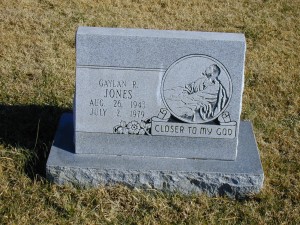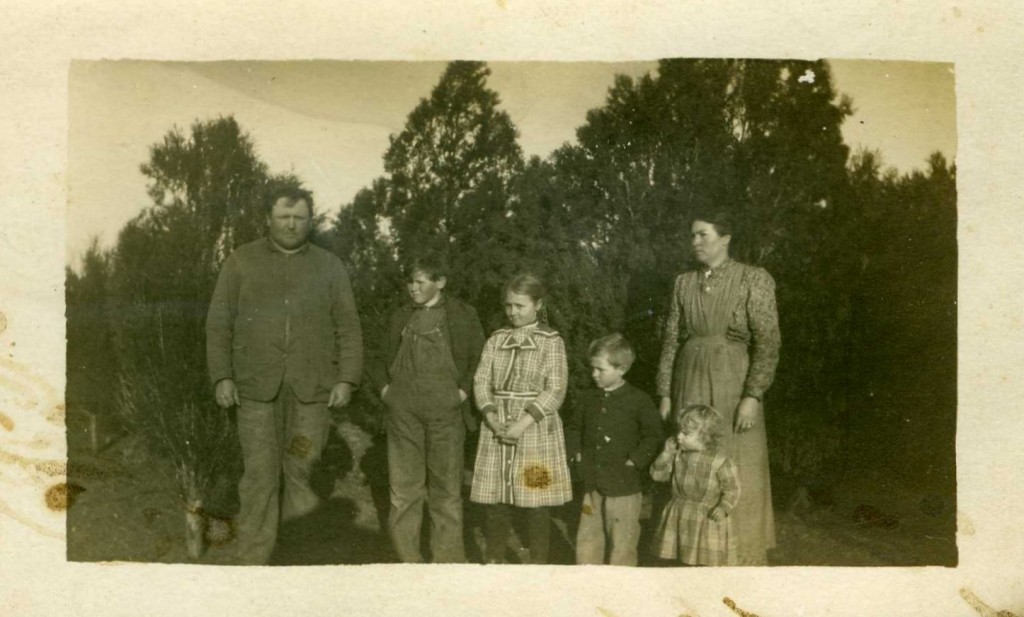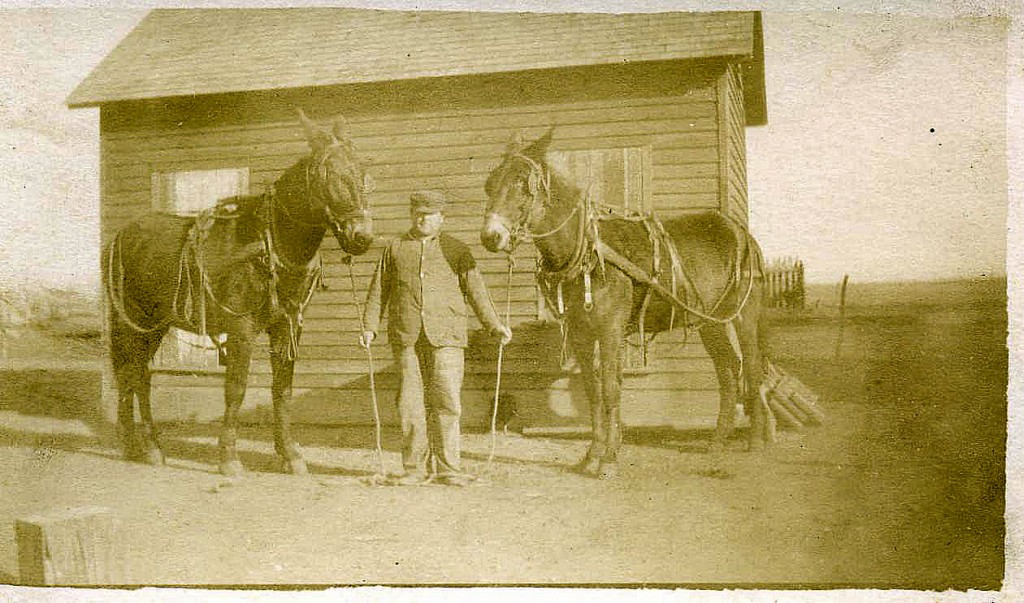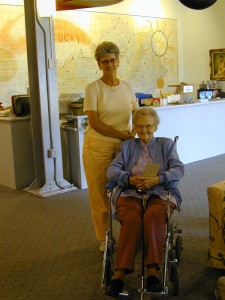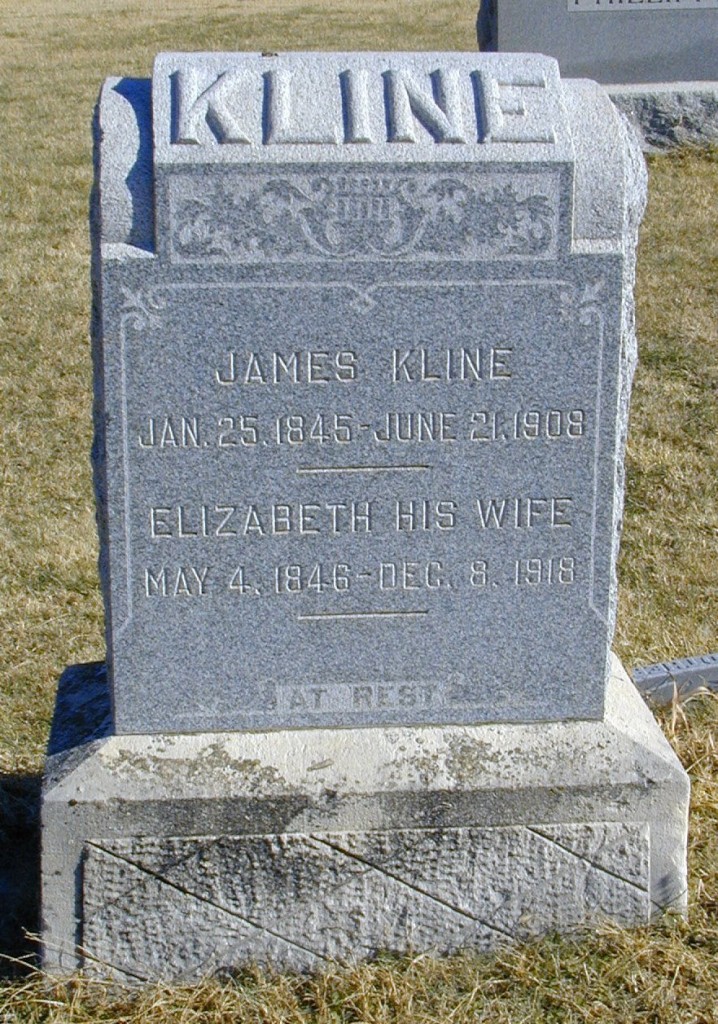Archive for the ‘Photographs’ Category
Tombstone Tuesday – Daryl M. Jones, Sr. and May (Bastien) Jones’ Stone
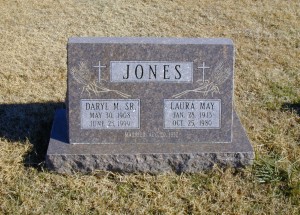
Daryl M Jones, Sr. & wife Laura May Bastien Jones Ryan Township Cemetery, Milan, Sumner County, Kansas
On Daryl and Laura May Jones’ Stone:
Jones
Daryl M. Sr
May 30, 1908 to June 32, 1999
Laura May
Jan 28, 1913 to Oct 25, 1980
Married Aug 20, 1932
Daryl and May were my Aunt and Uncle.
I did not know that May was not her first name until I read her obituary.
May died from leukemia, though she lived many years after she was diagnosed.
Daryl and May had three sons, Daryl Jr, Dale, and Gaylon. Dale and Gaylon are deceased and Gaylon is buried next to Daryl and May.
On Gaylan Jones’ Stone
Gaylan R. Jones
August 26, 1943
July 2, 1979
Dale was cremated and his ashes spread over the ocean where he loved to fish with his wife, Bonnie, who is also deceased.
My Uncle Daryl was an engineer without a degree. If he needed a piece of farm equipment, or needed something fixed or added to, he could most generally make it or fix it, and other farmers came often to have him fix or weld their equipment. After he retired from farming at age 70, he spent more time doing what he loved, which was ocean fishing near Aransas Pass, Texas.
Grew up on a Farm near Milan, Kansas…
Growing up on the farm near Milan, Kansas, Daryl was an excellent horseman, and trapped for furs to help the family income. He attended one year of college at Wichita State University, but there was no money to further his education, so he traveled to California, worked in the aircraft industry, and came back to the family and farm where he married May.
He could have done well in college and afterward, but I can’t imagine that he would have been any happier than he was farming, living on the farm, and growing crops and building and welding things for himself and others.
Tombstone Tuesday – Warner LaRue & Carrie Breneman Jones
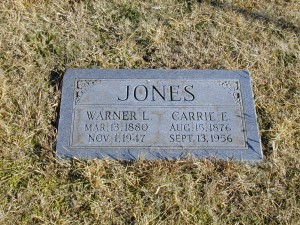
Warner LaRue and Carrie Esther (Breneman) Jones Ryan Township Cemetery, Milan, Sumner County, Kansas
By Sherry Stocking Kline
October 20, 2009
Warner LaRue and Carrie Breneman Jones, my grandparents…
Warner LaRue Jones was born in Kentucky. Probably Barren County, to Willis Washington and Martha Ellen Smith Jones on March 13, 1880, and died in Sumner County, Kansas on November 1, 1947.
Carrie Esther Breneman Jones was born (I believe in Nebraska. I do not have all of my info here where I can double check), to Constantine “Tom” Breneman and Salinda (Rose) Breneman on Aug 15, 1876, and died Sept 13, 1956.
They are both buried in Ryan Township Cemetery, Milan, Sumner County, Kansas.
My grandmother, Carrie Breneman Jones, was gifted at painting & hand crafting things…
I never got to meet my grandfather, and I was young when my grandmother died. But I remember that she was extremely gifted at hand crafting things, crocheting beautiful doilies, and pretty doll clothes. She taught herself to paint when she was already a senior citizen, and painted very life-like pictures of animals, particularly our families’ registered Ayrshire cattle.
We visited her often, and how I wish I had been old enough to ask the many questions that I now have!
Here is a photograph of their young family. My mother is the youngest child in this photograph, and there was one more child, Fern, born later. Fern died from pneumonia when she was sixteen, and is buried next to her parents.
My grandfather, Warner Jones, loved his favorite team of mules!
I can’t resist adding one more photograph that I just love! Wish I knew the name of the mules, but my mother told me that my grandfather loved those mules very much!
Saturday Night Genealogy Fun – The Day the Genealogy Serendipity Angels Smiled!
The following is from Randy Seaver’s Genea-Musings website! Thank you, Randy!
Yes, it’s Saturday Night, and time for some Genealogy Fun!
My friend, Leland Meitzler, posted his Top Ten list of “Most Satisfying Genealogy Events” yesterday – and it’s a good list – please read it and respond to it if you want to.
For today’s SNGF, if you choose to participate (cue the Mission Impossible music!), please:
1) Tell us about one (or more) “Satisfying Genealogy Moments” from your family history and genealogy research. What was it, and how did it make you feel? You can make a Top Ten list if you want to!
2) Write your own blog post, or make a comment on this post, or make a comment on Facebook, and tell us about your “moment in time.”
The Day the Genealogy Serendipity Angels Smiled!
by Sherry Stocking Kline, October 10, 2009
My Number One favorite all-time Genealogy Experience was one of those “ahhh moments” when Serendipity and the Angels smiled on us.
It was July of 2005, and my husband and I were leaving soon to visit our son in Illinois, and we were taking my mom who was 93 at the time, to Barren County, Kentucky for a day or two and try to locate my Mom’s dad’s childhood home.
I did some research before I left. I re-checked on library hours, wrote down addresses, packed up a notebook (and laptop), and called the South Central Kentucky Cultural Center in Glasgow, Kentucky to talk to the wonderfully helpful woman I had spoken with on a previous occasion.
I nearly hung up the phone…
I nearly hung up the phone when I learned that the woman who had been so warm and friendly before was not working.
That would have been a mistake.
I sighed to myself, decided to take a chance, re-state my facts and share my story with the woman who had answered the phone.
“I’m looking for information,” I said, “about my great-grandfather and great-grandmother, Willis Washington Jones and his wife, Martha Ellen Smith and her parents, Charles and Virginia Hawley Smith.”
There Was Dead Silence…
There was dead silence for at least three heartbeats.
And then she said (and here I still get goosebumps) “Charles and Virginia Hawley Smith are my great-great grandparents, too.”
“Oh. My. Gosh.” I thought.
“Hello, cousin!” was my astonished reply. The genealogical angels had not deserted me; they had given me a wonderful gift!
My brand-new cousin’s name was Nancy Bertram Bush, she was ‘into’ genealogy, and she invited us to give her a call when we got to Glasgow.
A couple of weeks later, we were in Glasgow. I stopped at the courthouse, looked up some land records, and learned more about my great-great grandfather Smith’s land holdings.
When we arrived at the South Central Kentucky Cultural Center, I gave Nancy another call and we were in luck, she was home.
Nancy Had a Gift for Mother…
She hurried over to the Center to meet us, (and a nicer new cousin I can’t imagine meeting). She brought along a treasure, a photograph of my mother’s grandparents (complete with the names) that had been mailed back to the family from Kansas and presented it to my mom.
Mom had never seen photographs of her grandparents and when we brought the photograph home, we were able to identify Willis and his wife Martha in two other photographs that we had.
Nancy offered to take us around Barren County with her husband to try to locate the former home of Willis and Martha Ellen. We went up hill and down dale, we stopped at one family farmstead that had Smith family buried there, and we tramped through tall grass to record names and take photographs, but this was not our destination.
Our next stop proved to be the home of Charles and Virginia Hawley Smith, and we were able to visit with the family and see the land and outbuildings, some of which might have actually been standing during Charles & Virginia’s time.
The Family Cemetery Had Been Returned to Farmland…
Thanks to researching cemetery books we already knew that their family cemetery had been returned to farm land, which was disappointing.
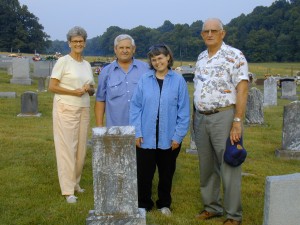
66 - L - R: Nancy Bertram Bush, Norman and Sherry Stocking Kline, Dennis Bush pay respects to family members at the Caney Fork Baptist Church, Temple Hill, Barren County, Kentucky
Next we stopped at the Caney Fork Baptist Church and cemetery and walked through the cemetery and paid our respects to cousins, great-aunts and great-uncles.
When we watched my mother get out of the car and in her words “stand on the land her father had played on as a child” and look around and see “where he came from,” it was a meaningful moment for us all.
We were grateful we were able to help her do this.
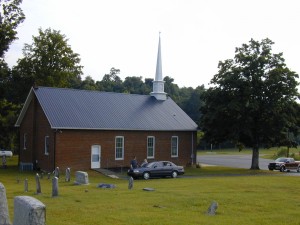
Dorothy Barry standing by car next to the Caney Fork Baptist Church & Cemetery - Temple Hill, Barren County, Kentucky
Thank You, Cousin, Nancy…
It was with deep sadness that we received word about two years ago that our new-found cousin, Nancy Bertram Bush, had suffered a heart attack and passed away.
Thank you for a wonderful Genealogical Moment in Time, cousin Nancy.
Grandpa – Tell Me ‘Bout the Good Old Days…
by Sherry Stocking Kline
First published in the Wichita Eagle’s Active Life Magazine – April 2002
Getting Grandpa to talk about the “good ole’ days” really isn’t as hard as you might think. All you have to do is set the stage, bring along some props, and be prepared with plenty of questions.
Pat Gaddie grew up listening to her Grandpa Sam tell his Irish jingles, share stories about blue racer snakes chasing him through fields, and the wagon trip he made in 1902 when he was eighteen and his family moved from Tennessee to Oklahoma.
“He lived next door to us when I was small,” Gaddie said, “and when I was eight or nine years old, he used to tell stories to entertain me.”
How to Keep Them Story Telling…
Not everyone enjoys reminiscing, but if your Grandpa (or Grandma) does, here are a few tips to keep them story telling.
Decide what you want to know, make a list of questions, then ask the most important ones first.
What’s your priority? Is it facts, figures, dates, and places, the who begat who and where or when, or is it the stories that you want to hear?
Are there family legends that you want to verify or clarify, or do you want to hear how he proposed to Grandma, laugh about the night he and his bride were chivareed, or see D-Day through his eyes?
Set the stage.
Old photographs and family memorabilia are great memory triggers, and can prompt a flood of memories, so bring out the high school play bills and yearbooks, wedding photos, and photographs of the plane Grandpa flew in the service. When he shows you the photo of his first car, be sure and ask him about the job he took to pay for it.
Take field trips to old schools, cemeteries, and other meaningful places, and travel to Grandpa’s hometown and drive by his old schoolhouse. You may learn who put the snake in the teacher’s desk, the story behind Grandpa’s nickname, and more.
Remember that Grandpa’s dates may be approximate, as he’ll likely remember events as happening “the year of the big blizzard, the summer of the drought, or just before Beverly was born”.
Bev Malone interviews older family members to flesh out stories and verify the information.
“The best way to get the stories flowing about family members is to ask about people and things, not personalities,” Malone said.
Make sure your cameras, and audio or video recorders have fresh batteries, and take along spares. If you need an extra memory card for your cameras (or film) be sure to take that along, too.
“Recorders can make people nervous,” Malone said, so she breaks the ice by asking, “Do you mind if I tape this? My brain can’t keep it all in my head.”
Take notes, just in case technology lets you down, and transcribe your notes as soon as possible.
Need help with your list of questions?
There are books that can help, such Emily Anne Croom’s “Unpuzzling Your Past Workbook” with questions tailored for different decades in history, and Janice T. Dixon’s “Family Focused” with question lists and suggestions to help you conduct interviews and gather information.
What’s Dixon’s advice in “Family Focused” to interviewers?
“Be relaxed, don’t interrupt, don’t contradict, and don’t ask questions that can be answered with a yes or no.”
“Keep the flow of conversation going,” Dixon said, “you can go back and ask questions later.”
Gaddie cherishes and shares her Grandpa Sam’s stories with her family, a process that can add valuable information to your research as well as give you new questions to ask.
With a little planning, the next time you visit Grandpa, you may learn more about your grandfather, your parents – perhaps even yourself.
And This Brother Came to Kansas – Tombstone Tuesday – James and Elizabeth (Conver) Kline
by Sherry Stocking Kline
Written for FamilyTreeWriter.com – October 5th, 2009
Though family and family history has always been important to me, I have my father-in-law to thank, at least in part, for my interest in researching genealogy.
My Father-in-Law Got Me Started…
It was my father-in-law who put the bug in my ear that “he sure would like to know more about his family” though he also let me know at the same time that he was afraid to find out.
Like many families, there was a ‘story’ involved. Three brothers, or some such number, and one went this way, one went another, they had an argument, and they never spoke again.
The Brothers Argued and Never Spoke Again?
The story that Pop, my father-in-law had heard was that the brothers came west, and then they argued on the way, and one came to Kansas and they never spoke again. And Pop was afraid that I might find something about his grandfather that would be, well, really embarrassing, so though he really wanted to know, he was more than a little hesitant.
He probably knew that the mystery would be a challenge that I couldn’t resist, and he was right.
I Was Clueless When I Began to Research…
I began to research. And it’s funny now how clueless I was when I started. My first trip to the library I was simply opening up Pennsylvania genealogy books looking for the Kline name, hoping to get lucky!
Kline isn’t all that common here, so I had no idea that Kline (meaning ‘little man’) is pretty much the German version of Smith in Pennsylvania.
Bless her heart, Marsha Stenholm (now retired) of the Wichita Public Library took me under her wing, and we actually found a little info that first trip, and oh, my gosh, I was hooked!
James Ran in the Cherokee Strip Land Rush Race…
Here is the tombstone for Pop’s grandfather and grandmother. They came from the Venango County area in Pennsylvania, and made a stop in Illinois and also in Iowa, leaving farms there to come to Caldwell, Sumner County, Kansas to make a run in the Cherokee Strip Land Rush Run into Oklahoma. When they did not win any land in that race, they settled near Milan, Sumner County, Kansas.
James and Elizabeth Conver Kline are buried in the Ryan Township/Milan Cemetery in Sumner County, Township Cemetery, Milan, Sumner County, Kansas.
And though I did find that the siblings may have had some disagreements, it seems as though several kept in touch with one another, even after they all re-located to their new homes in the west.
Still a Work in Progress…
Even though Pop is gone now, this is still a ‘work in progress’ and I’ve connected with other distant branches of the family, and they’ve added much to the family tree information.
Journal Your Summer Photos Now!
by Sherry Stocking Kline
first published in Wichita Eagle’s Active Life Magazine – September 2000
Now that summer’s over, and you’ve got a shoebox full of vacation, grandchildren, wedding, and graduation photographs, it’s time for you to preserve those memories between the pages of a book, like a pressed flower, to be enjoyed again and again.
So where do you start first?
“Get some history attached to those photos,” said Bob McCreary, “that’s the first and probably the most important step.”
McCreary and his wife Kathy co-own Scrapbook Garden, Wichita, Kansas. McCreary said that Kathy carries photographs with her in her purse and whenever she has a few minutes while watching television, waiting for the doctor, or waiting to get a driver’s license she sorts photos and makes quick notes on the back with a photo safe pencil.
Once you have them sorted, McCreary said it’s really a quick step after that to put the photos in an acid-free, lignin-free photo album, and then “journal” or tell about the photos.
Each year, Gerry Reimer does a summer vacation album, and adds more pages to her all-Christmas album.
Journals Don’t Have to Be Elaborate…
Reimer said not to let your friends’ elaborate journals scare you off. “Streamline,” Reimer said, “get the photos on the page, and get the people identified.”
“First of all,” Reimer said, “Tell yourself it’s o.k. not to use all the photos you have.” Reimer said to choose pictures that tell who you are and where you were at that time, and be sure and include names and dates in your albums.
“I don’t keep a travel diary,” Reimer said, but Reimer said she jots down a few notes, picks up ticket stubs, colored brochures, saves travel itineraries and whatever else they might want to use in their vacation albums.
Reimer said you’ll know what you want to do, and what you don’t, after you finish your first book. Reimer’s first photo album was her wedding album.
“We’d been married 49 years,” Reimer said, and I didn’t like our wedding photos, so I had a wonderful time cropping off what I didn’t like and journaling about the pictures.” Reimer said she does “bullet journaling”, or writes short statements under most photos, saving long stories for special photographs or events.
Start With Recent Photo’s…
Bonnie Loewen, Creative Memories consultant, said the easiest way to get started is with your last roll of film while your memory of the event is fresh, and work your way backwards.
Tell A Story…
Loewen said to tell a story with words as well as with pictures. How were you feeling? What was going on in the family, and the world? Loewen said even the current price of bread and gasoline will be interesting to future generations.
Loewen said to write as you would talk, don’t worry about punctuation, and write a sloppy first draft. You can re-write it later, Loewen said.
Answer the Five W’s – Engage the Five Senses…
Think about the five senses and the five W’s, advised both McCreary and Loewen, adding that it will make ideas for captioning your photos come easier. Just remember to answer the questions who, what, when, where, and why questions, and engage the emotions by writing about how something looked, sounded, tasted, felt, and smelled.
Preserve Your Handwriting, too…
McCreary said and its faster to use a computer to journal, but it’s not as personal, so he said not to be afraid to write in pencil and go over it later with a permanent marker, or even cover up mistakes with cardstock.
“Some people don’t like their handwriting,” McCreary said, “but people years from now will cherish seeing the handwriting of the person who made the journal.”
Scrapbooks can help bridge the generation gap, so along with vacation, wedding and family photos, include stories and pictures of military service and other events to help future generations understand the times you lived through, and what makes your family special.
Ordinary Days are Important…
Loewen said it’s also good to make pages of what an ordinary day was like in your family, too, not just the special events. “And make a signature page,” Loewen said, with your name, date, who the album is for, and why you did it, “it’s kind of like signing a quilt.”
If you have a lifetime of photographs ask for help from your family. Reimer said that kids and grandchildren are great to help photo captions.
McCreary agreed, “it’s good to get family members involved.”
“Make it a fun activity,” McCreary said, “have everyone sit down and talk about the photos, and try to communicate some of the emotion.” You get different perspectives of an event by talking to different people.
“It’s really exciting that people are making a legacy and trying to pass on their roots and their values,” Loewen said, “values can be lost in one generation if they are not preserved.”
“People will forget you in one generation if you don’t tell your story,” Loewen said, “you can make such a difference in people’s lives with a scrapbook.”
“In a sense,” Reimer said, “your whole book is the story of your family.”
Can You Salvage Damaged Photographs?
By Sherry Stocking Kline
published in the Wichita Eagle’s “Active Life” magazine in November 2005
If disaster strikes, whether it’s Hurricane Katrina, your water heater sprung a leak, or your photographs have water and smoke-damage from a fire, don’t make the trash your first destination of choice for the remains.
Sometimes, even wet, stuck together photographs can be salvaged, but you have to act fast.
“A lot depends on the circumstances,” said Darrell Garwood, preservation officer, library archives division, Kansas State Historical Society, “There is a lot of dirt and contaminants in flood water,” Garwood said, “If they have been in water, especially dirty water longer than 48 hours they may not be able to be re-claimed.”
A lot also depends on what type of photographs are damaged. Are they fairly modern? Are they old? One-of-a-kind? Hand-tinted? What kind of paper are they on?
Before you do anything, you need to know what kind of photographs you are dealing with, and it may be necessary to consult a professional for help. To help you determine what kind of photographs you can safely repair yourself, or if you have no choice but to attempt the repair yourself, there are books, such as “How to Save Your Stuff From a Disaster” by Scott Haskins, and websites such as Northeast Document Conservation Center, www.nedcc.org, and the Kansas State Historical Society’s website at www.kshs.org, (click on preserve) can help you determine what kind of photographs you have, and how best to preserve them.
According to Gary Albright, senior paper/photograph conservator, Northeast Document Conservation Center, there are a number of different photographic processes, and while some photographs can be immersed for a day or more and still be restored, others will be completely ruined by a just a few minutes of water exposure.
“Time is of the essence: the longer the period of time between the emergency and salvage, the greater the amount of permanent damage that will occur,” Albright said.
Haskins stated that it’s best to consult a professional who can deal with the photographs without adding to the damage, especially if you have old or vintage photographs.
Wet photographs should always be a priority. Albright said that wet photographs should be air dried or frozen as quickly as possible to prevent mold damage. (Yes, he really did say frozen.)
If the photographs are still wet, it’s best to put them in clean, cool water, distilled water. Change the water often to make sure the water stays clean. Do not use bleach, detergent, fungicide or disinfectants. Do not touch, rub, scrub, or try to force stuck-together photographs apart. Handle them by the edge only, preferably with a blunt, clean pair of tweezers.
Drain excess water off the photographs, and lay them out flat, and separated, on clean, lint-free material to dry. Do not use newspapers. Negatives should be hung up by the edges to dry vertically. Circulate the air the help speed up the drying process and to prevent mold. Do not use a heater.
Can’t deal with them right away? Freeze any photographs that cannot be cleaned and dried within 72 hours.
If they are already wet, rinse off any dirt, mud, etc., separate photos or groups of stuck together photographs with wax paper, put them into zip lock freezer bags and put them in the freezer. Do NOT stack anything on top of them.
If your photos are damaged, you still may be able to scan them at 300dpi or better, and use image editing software such as Adobe Photoshop or Corel’s Paint Shop Pro to repair copies of your damaged photographs. You can use that new, digital copy to make new photographs.
Garwood stated that prevention is the most important thing, and Garwood agreed.
“Address prevention first,” Garwood said, “store them properly and avoid basement storage because basements are always the first thing to flood in a house.”
After prevention, Garwood suggested that you spend a little time in disaster preparedness. Know where your photographs, family letters, video tapes, DVD’s, and important papers are, so you can go right to them for a speedy recovery should it become necessary.
If possible, Garwood said, have back-ups and replacements.
“Make this part of your emergency preparedness plan, and remember that your papers and photos are not as important as yourself,” Garwood said, “People should always come first in a disaster.”
2009 Author’s Suggestion: Before freezing or beginning any restoration attempts, consult with professionals if at all possible.
This article idea came to mind following Hurricane Katrina, and the tornado that struck the Haysville, Kansas area. We drove through the tornado devastation where houses were turned into matchsticks, and papers and pictures were blowing in the wind. I realized that after life and limb were safe, it was the thought of losing my photographs that bothered me most if we were to be struck by a tornado.
Photographing Your Family History
by Sherry Stocking Kline
Wichita Eagle’s June 2001 “Active Life”
When Tammy Pontious’s great-grandchildren look at her family history scrapbook many years from now, Pontious doesn’t want them to see stiff, posed photos of people in their Sunday best clothes. She wants them to be able to see what they were like when they were working and playing.
“The key is to carry your camera with you,” said Pontious, who keeps her camera handy and often carries it along when she drives her daily school-bus route. “You’ll have missed opportunities if you don’t.”
Bob McCreary, who co-owns Scrapbook Garden, www.scrapbookgarden.com, with his wife Kathy, agreed. Many people keep one of the “point-and-shoot” or disposable cameras that take remarkably good photographs handy, said McCreary, adding that for a clearer photo with a point and shoot camera, you must aim the focal point of the camera at someone in the group and not at the background.
Because photographing people in front of a simple background is often better, Pontious looks at the background before snapping and decides if it will help tell the story or just clutter up the photograph, though with today’s digital software, it’s fairly simple to crop out, blur, or even replace an unwanted background.
Close-up’s are great for people photos and eliminating distracting backgrounds, but check your camera’s manual before taking one, advises Kodak.com, as some cameras cannot focus closer than four feet from the subject. When using a flash, you need to check your flashes’ useful range as well. For many cameras, anything past 10 to 12 feet is a dark blur, as any concert goer can attest to after snapping photo after photo only to get home with photos of a shiny bald head about eight feet in front of them.
Pontious, who calls herself “a picture fanatic,” said you need to take lots of photographs.
“You just can’t be stingy with the film,” Pontious said, “for $8.00, you’ll probably come up with two or three photos that you’re in love with.”
For sharp, clear photographs, hold the camera steady, and try Pontious’ technique of visualizing the photo before gently pressing the shutter button. Pontious said she also tries a variety of different and unique angles, works to capture candid facial expressions, and likes to catch her family’s silhouettes in profile shots.
Pontious also ‘stalks’ the wildlife on their river farm, catches her dogs in silly poses, snaps her mom relaxing on the porch swing, and her husband and son while they work, hunt, and fish.
“That’s our lives,” Pontious said. Our descendants may say, “look what great-grandpa did back in those days.”
“You know the old saying about 1000 words? There is a lot of information that finds its way into a photo almost by accident, and sometimes it becomes significant to us later.” McCreary said.
“It’s candid shots of people doing things that tell the story of our lives,” McCreary said, “if Uncle Ralph was a farmer – take a photo of him on his combine. If someone hunts or fishes a lot get a photo of the big catch.”
To avoid that squinty-eyed look outdoors, photograph people on overcast days or in the shade using fill-in flash to highlight faces and chase away the shadows. Pontious said her favorite time of the day to take outdoor photographs is in the early morning or late afternoon, and said that she also likes to photograph subjects using the warm, natural lighting near a window.
“I just don’t like what I end up with at high noon,” Pontious said, “the photos all end up looking washed out.”
Pontious said that she looks for little situations and happenings, but she also works to create photographic events.
How does she do that? She sets up fun events for people to enjoy. One event that yielded some favorite photographs was a tea party she held for several laughing and giggling young cousins while she sat the corner of the porch “click, click, clicking away.”
McCreary said that while you are capturing your family in photographs, don’t forget to photograph your home(s), inside and out, and your yard, farm, barns, and outbuildings that are a part of your life today, and may be only a memory someday.
Pontious treasures the family resemblances she sees in the photographs of grandparents that died before she was born. She said that many of their photographs have been passed down from one person to another, from one generation to another, from trunks to attics, and came on covered wagons from there to here. She feels she is handing down a family history treasure to her son Dallas.
“A photo can tell you everything in the world,” Pontious said, “emotions, social status, whether they were rich or poor, lifestyle, facial features, looks and personality. What I would hope,” Pontious said, “is that it will tell them my values, hopes, dreams and what I accomplished.”
Someday she hopes that her descendants will look at her family history book and read the anecdotes, stories, and poems that are woven throughout, and will choose to preserve it, and hand it down again.
“Who knows where they’ll go in my son’s journey,” Pontious said.
